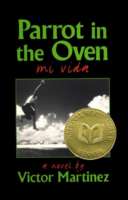
Parrot in the Ove
: Mi Diva
Written by Victor Martinez
HarperCollins Publishers, 1998, 216 pp.
ISBN: 978-0064471862
You could be a thousand-dollar person or a hundred-dollar person-even a ten-five-, or one-dollar person. Below that, everybody was just nickels and dimes. To my dad, we were pennies. (p. 25-26)
An award-winning, realistic novel that takes place in the Valley Central Projects, Parrot in the Oven addresses how a young fourteen-year-old Mexican-American boy struggles to find himself. This book focuses on the difficulties of being part of culture that is often plagued with stereotypes, such as unemployment, laziness, alcoholism, poverty stricken, gang members, sexually active teenagers, teen marriage and criminals. This novel follows Mexican-American teenager Manuel “Manny” Hernandez who lives in poverty with his unemployed, alcoholic father, his overworked, stressed out mother, his lazy older brother, Bernando, his sexually active older sister, Madga, and his baby sister Pedi. Manny struggles when faced with his family’s financial situations since his jobless dad spends all their money on alcohol. He is fearful of the neighborhood.
Manny’s mother wants him to attend a different school where the “white” children go so that he can obtain a brighter future. Although Manny is hesitant to go to a new school, he doesn’t disagree with his mother. He goes to obtain his transcript at his current school when he finds his old teacher. The teacher, seeing his poor dress attire, offers him a ride home and gives him twenty dollars for “school supplies.” Unfortunately, his dad finds the money and he goes on a drinking spree for two days. He ends the spree infuriated with his wife’s behavior as she drags him out of a bar. He then goes on a rampage and chases her with a rifle only to end up in jail. Manny’s life is anything but dull. His struggles only continue and he realizes all he really wants is to be respected–a vato firme. Will Manny fall into temptation? Will he pull away from gangs and rise above his family or will he be lured in by the promise of feeling like a family and plenty of pollitas willing to make out?
The Hernandez family members are real characters whose experiences are ones that many readers can relate to. Manny’s experiences in particular speak to kids who feel that they don’t belong, whether they have to put up with others looking down on them because of their ethnic background or their social economic status or whether they simply just long to be someone else- someone smarter, richer, whiter or someone stronger that other people would respect. Readers may find themselves questioning why some people are faced with cultural discrimination.
Parrot in the Oven brings to life the opportunity for some to see their lives in print and for others to develop an understanding of the difficulties of growing up with cultural discrimination. Residents of the border town Rio Grande Valley, where the majority of the population is Hispanic, commonly see families going through issues such as the ones in Parrot in the Oven. Through our own experiences, we can relate to having families that work in the fields, living paycheck to paycheck, sisters who are pregnant at 16, and experiencing peer pressure while wanting more for our personal lives and working to overcome the stereotypes.
Author Victor Martinez was born as the fourth child in a migrant family of twelve in Fresno, California on February 21, 1954. He attended California State University at Fresno and Stanford University. He worked as a field laborer, welder, teacher, and office clerk. He wrote culture reviews for El Tecolote and published a magazine called Dinton. His poems, short stories, and essays have appeared in several journals and anthologies. Later, in life he became a full-time author. His books include Caring for a House and Parrot in the Oven. He died of cancer on February 18, 2011 at the age of 56.
The winner of the National Book Award for Young People’s Literature in 1996 and the Pura Belpré Award, Parrot in the Oven could be used in a high school classroom to discuss the stereotypes that have been imposed on Mexican culture. While some of the stereotyping may be considered brutal and offensive it successfully demonstrates the struggles faced by some Mexican-American children.
Readers who are interested in reading a coming of age story in which a Mexican American boy struggles to follow his dream despite distractions might enjoy Living Up the Street (Gary Soto, 2012). Another book on this theme is Buried Onions (Gary Soto, 2012), the story of a 19- year-old Mexican-American boy living in a violent barrio in Fresno, who is trying to walk a straight line despite the temptations.
Melissa Ann Becerra and Lisa Marie Ochoa, University of Texas Pan American, Edinburg, TX
WOW Review, Volume VI, Issue 1 by Worlds of Words is licensed under a Creative Commons Attribution-NonCommercial-ShareAlike 4.0 International License. Based on work at https://wowlit.org/on-line-publications/review/vi-1/

Dear Ms. Wilson,
I would be grateful for some details – which are the facts that I neglected to look up, specifically on Wikipedia?
The novel was written in 2005 and I consulted countless books and other media in order to describe two Jewish families in the 1930s and 1940s as credibly as possible. A good deal of the two years of writing this novel (the German original being much longer than the American edition) was spent on research in Berlin and London. Before going into print, the finished novel was read and approved by two scholars with a degree in Judaism. One of them spent most of her life in Israel.
I am very sorry for any mistake which remained in the book, also for maybe not quite catching the spirit of being Jewish in Britain in the 1940s.
With best wishes,
Anne Voorhoeve